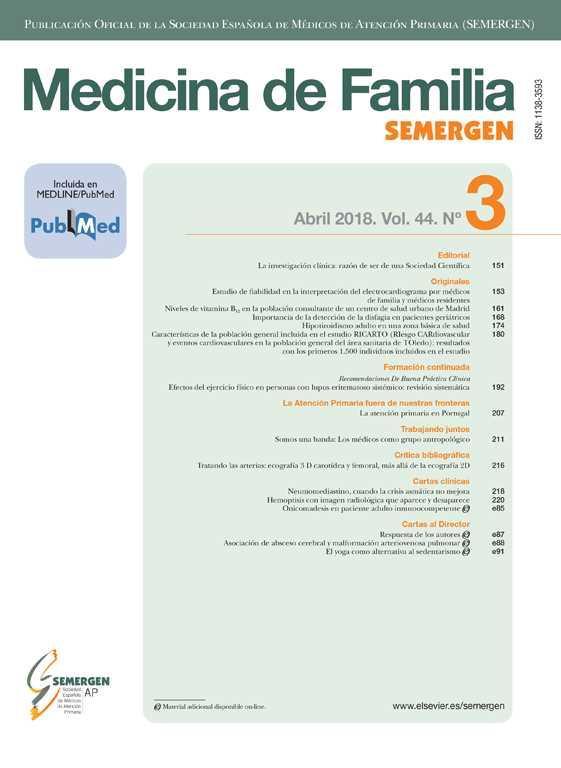. Conocer el grado de ansiedad/depresión y deterioro cognitivo en una población rural y su relación con variables sociodemográficas, hábitos tóxicos y saludables y ciclo vital familiar (CVF).
Metodos. Estudio descriptivo transversal. El ámbito de estudio fue población rural, perteneciente a una consulta periférica de Zona Básica de Salud. De un total de 248 mayores de 65 años, participaron 170 pacientes, no institucionalizados, que acudían a consulta a demanda o programada. Las mediciones realizadas fueron: A) Variables sociodemográficas: edad, sexo, hijos, estado civil, nivel de instrucción y convivencia. B) Hábitos tóxicos y saludables: tabaco, alcohol, ansiolíticos, analgésicos, andar y actividades ocupacionales. C) CVF. D) Escala de ansiedad/depresión de Goldberg (EADG) y prueba de Pfeiffer. Se realizó un estudio descriptivo de cada variable y análisis bivariante mediante χ2 de Pearson.
Resultados. A) Variables sociodemográficas: El perfil del encuestado es mujer (106/170; 62,4%) entre 65-69 años (57/170; 33,5%), casada (108/170; 63,5%) con tres hijos (56/170; 32,9%), nivel de instrucción leer y escribir (145/170; 85,3%) y vive en casa propia con cónyuge (108/170; 63,6%). B) Hábitos tóxicos y saludables: 1. El 20% (34/170) y el 96,5% (164/170) consumen alcohol y no fuman, respectivamente. 2. EL 33% consumen analgésicos y ansiolíticos diariamente. 3. El 57,6% (98/170) caminan 30 minutos diariamente. 4. La TV/radio es la ocupación de ocio más frecuente (58,2%). C) CVF: el 42,9% (73/170) se encuentran al final de la fase de contracción. D) Pruebas: 1. EADG: el 16,5% presentan posible ansiedad y el 17,6% depresión. 2. Pfeiffer: el 14,7% presentan deterioro cognitivo leve. E) Relaciones: 1. La ansiedad/depresión presenta una predisposición mayor en mujer (p = 0,0090), con duelo (p = 0,0027). Caminar entre 30-60 minutos/día disminuye la probabilidad de depresión (p = 0,0385). 2. Presentar deterioro cognitivo leve se relaciona con ser mujer (p = 0,0156), mayor de 80 años (p = 0,0097), leer y escribir (p = 0,0000) y sin cónyuge (p = 0,0004).
Conclusión. 1. Alta prevalencia de patología psicosomática (ansiedad/depresión). 2. Ser mujer y la ausencia del cónyuge predisponen a ansiedad/depresión y deterioro cognitivo.
. Know the degree of anxiety/depression and cognitive deterioration in a rural population and its relationship with socio-demographic, toxic and healthy habits, and familial life cycle (FLC) variables.
Methods. Descriptive cross sectional study. The study scope was rural population, belonging to a Basic Health Area peripheral out-patient clinic. A total of 170 patients out of 248 over 65 years participated. They were not institutionalized and they came to the clinic on demand or programmed visit. The measurements performed were: A) Socio-demographic variables: age, gender, children, civil status, schooling level and cohabitation. B) Toxic and healthy habits: tobacco, alcohol, anxiolytics, analgesics, walking and work activities. C) FLC. D) Goldbert anxiety/depression scale (GADS) and Pfeiffer test. A descriptive study of each variable and bivariate analysis by Pearson's χ2 were performed.
Results. A) Socio-demographic variables: the survey profile is woman (106/170; 62.4%), between 65-69 years (57/170; 33.5%), married (108/170; 63.5%), with three children (56/170; 32.9%), schooling level reading and writing (145/170; 85.3%) and living in own home with spouse (108/170; 63.6%). B) Toxic and healthy habits: 1. 20% (34/170) and 96.5% (164/170) consumed alcohol and did not smoke respectively. 2. 33% consumed analgesics and anxiolytics daily. 3. 57.6% (89/170) walked 30 minutes daily. 4. TV/radio is the most frequent leisure time occupation (58.2%) C) FLC: 42.9% (73/170) were at the end of the contract phase. D) Tests: 1- EADG: 16.5% have possible anxiety and 17.6% depression. 2. Pfeiffer: 14.7% had mild cognitive deterioration E) Relationships: 1. Anxiety/depression present a greater predisposition in women (p = 0.0090), with mourning (p = 0.0027). Walking between 30-60 minutes/day decreases probability of depression (p = 0.0385). 2. Presenting mild cognitive deterioration is related with being a woman (p = 0.0156), older than 80 years (p = 0.097), reading and writing (p = 0.0000) and without spouse (p = 0.0004).
Conclusions: 1) High prevalence of psychosomatic disease (anxiety/depression). 2) Being a woman and absence of spouse predisposes to anxiety/depression and cognitive deterioration.






